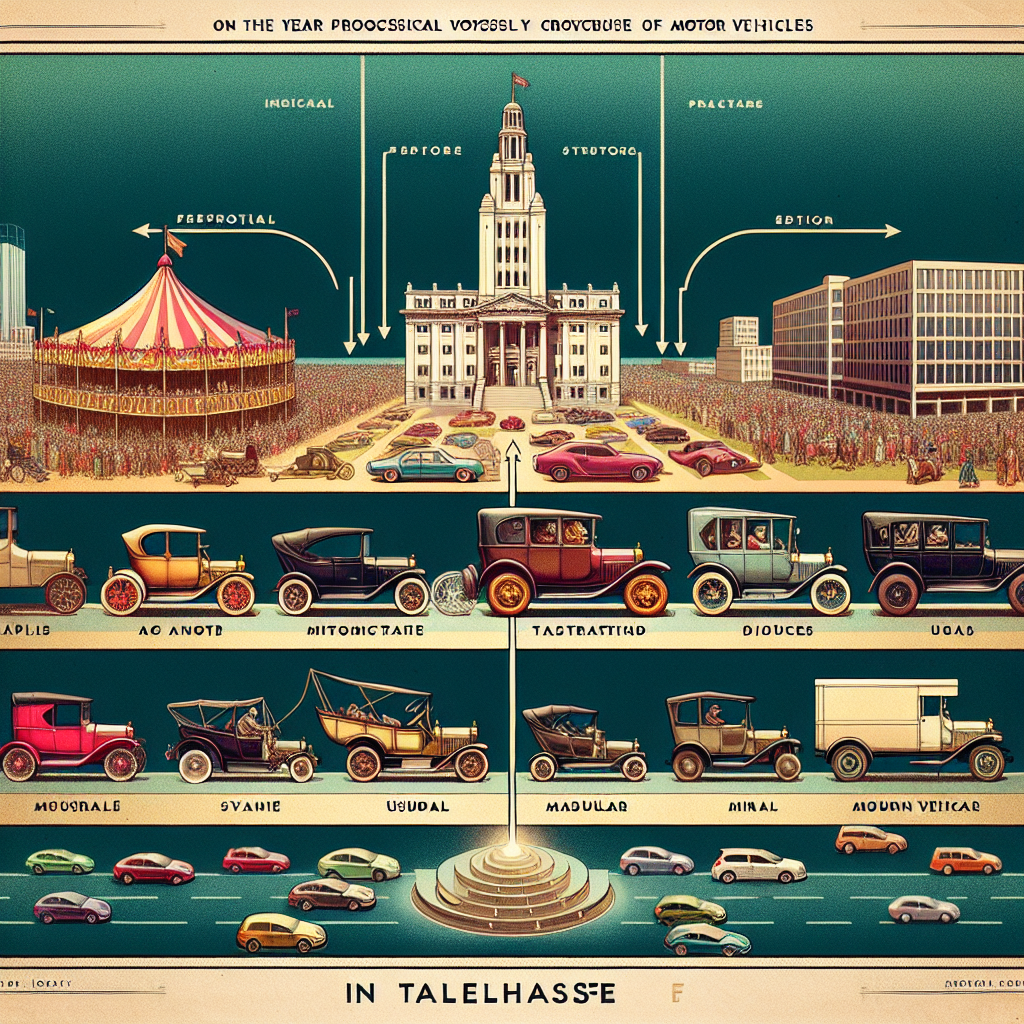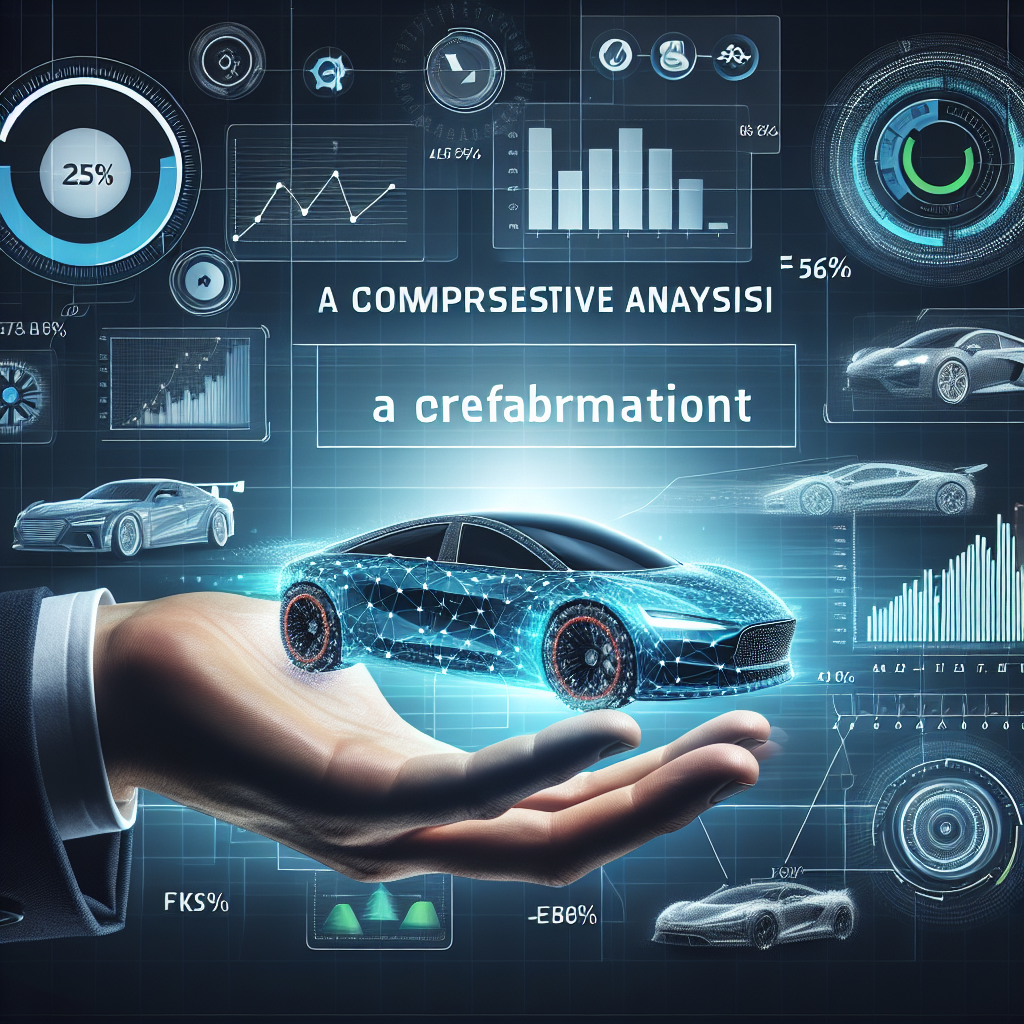From Spectacle to Necessity: How Tallahassee’s Automotive Landscape Has Transformed Over Time
Imagine a time when automobiles were not a common sight on the streets of Tallahassee. Just over a century ago, these mechanical wonders were considered nothing more than circus curiosities, attracting crowds with their loud engines and peculiar designs. But oh, how times have changed! Today, Tallahassee is a bustling city filled with sleek, modern vehicles that have become an integral part of our daily lives. In this article, we will delve into the fascinating journey of automobiles in Tallahassee, tracing their evolution from circus curiosities to mainstream vehicles.
From the early 1900s, when the first automobiles made their appearance in Tallahassee, to the present day, where they dominate our roads, the transformation has been nothing short of remarkable. We will explore the early struggles faced by early car owners, the impact of the automobile on Tallahassee’s infrastructure, and the role of key individuals and organizations in shaping the city’s automotive landscape. Additionally, we will highlight some of the iconic car models that have left a lasting impression on Tallahassee, and delve into the future of automobiles in this rapidly evolving city. So fasten your seatbelts and join us on this journey through time as we uncover the fascinating evolution of automobiles in Tallahassee!
Key Takeaways:
1. The early days of automobiles in Tallahassee were marked by curiosity and spectacle, with circus-like exhibitions showcasing the new technology.
2. The establishment of automobile dealerships and repair shops in the early 20th century paved the way for the integration of automobiles into everyday life in Tallahassee.
3. The of Ford’s Model T revolutionized the automobile industry, making cars more affordable and accessible to the general public in Tallahassee.
4. The construction of paved roads and the implementation of traffic regulations in Tallahassee played a crucial role in the widespread adoption of automobiles as a primary mode of transportation.
5. The evolution of automobiles in Tallahassee reflects the broader societal changes and technological advancements that occurred throughout the 20th century, shaping the city’s urban landscape and way of life.
The Controversial Aspects of ‘The Evolution of Automobiles in Tallahassee: From Circus Curiosities to Mainstream Vehicles’
1. Impact on the Environment
One of the most controversial aspects of the evolution of automobiles in Tallahassee is their impact on the environment. As the number of vehicles on the road has increased over the years, so has the pollution they generate. The burning of fossil fuels in cars releases greenhouse gases, contributing to climate change and poor air quality.
Proponents of automobile evolution argue that advancements in technology have led to cleaner and more fuel-efficient vehicles. They point to the increasing popularity of electric cars as evidence of progress towards reducing emissions. However, critics argue that the overall environmental impact of automobiles, including the production and disposal of batteries, still poses significant challenges.
Addressing this controversy requires a balanced approach. While it is important to acknowledge the negative environmental consequences of automobiles, it is also crucial to recognize the ongoing efforts to mitigate these impacts. Transitioning to electric vehicles, improving public transportation systems, and promoting alternative modes of transportation can all contribute to a more sustainable future.
2. Traffic Congestion
Another controversial aspect of the evolution of automobiles in Tallahassee is the issue of traffic congestion. As the population has grown and the number of cars on the road has increased, traffic congestion has become a significant problem in the city. This not only leads to frustration among drivers but also has economic implications, as time wasted in traffic translates to lost productivity.
Advocates for automobile evolution argue that advancements in transportation infrastructure, such as the construction of new roads and highways, can help alleviate traffic congestion. They also emphasize the importance of urban planning that promotes walkability, cycling, and public transportation as alternatives to driving. However, critics argue that building more roads only encourages more car usage and does not address the root causes of congestion.
To address this controversy, a comprehensive approach is necessary. Investing in alternative modes of transportation, improving public transit systems, and implementing smart traffic management strategies can help reduce traffic congestion. Additionally, promoting urban planning that prioritizes mixed-use development and reduces the need for long commutes can also contribute to a more efficient and sustainable transportation system.
3. Social Equity
The evolution of automobiles in Tallahassee has also raised concerns about social equity. Access to personal vehicles can be a significant factor in socioeconomic mobility, allowing individuals to access job opportunities, education, and essential services. However, not everyone has equal access to car ownership, and this disparity can exacerbate existing social inequalities.
Proponents argue that automobile evolution has made vehicles more affordable and accessible to a wider range of people. They highlight the availability of financing options and the rise of ride-sharing services as examples of increased accessibility. However, critics point out that car ownership still comes with significant costs, including maintenance, insurance, and fuel expenses, which can be prohibitive for low-income individuals.
Addressing the social equity controversy requires a multifaceted approach. Investing in public transportation infrastructure, improving the affordability of alternative modes of transportation, and implementing policies that prioritize underserved communities can help bridge the gap in access to mobility. Additionally, promoting initiatives that provide affordable car-sharing options or support carpooling can also contribute to a more equitable transportation system.
The Early Days: Automobiles as Circus Curiosities
In the early 1900s, automobiles were a rare sight on the streets of Tallahassee. They were seen more as circus curiosities than practical modes of transportation. The first automobiles to arrive in the city were often showcased in circuses and fairs, attracting crowds of curious onlookers. These early vehicles were a far cry from the sleek and efficient cars we see today. They were noisy, unreliable, and required constant maintenance.
One notable example of an early automobile in Tallahassee is the “Tin Lizzie,” a Ford Model T that made its way to the city in 1908. The arrival of this vehicle caused quite a stir among the locals, who had never seen anything like it before. It became a popular attraction, with people lining up to take a ride in the “horseless carriage.”
The Rise of the Automobile Industry in Tallahassee
As the 20th century progressed, the automobile industry began to take hold in Tallahassee. Local entrepreneurs recognized the potential of this new mode of transportation and started opening car dealerships and repair shops. The city saw a rapid increase in the number of automobiles on its streets, as more and more people embraced the convenience and freedom that cars offered.
One of the key players in the early automobile industry in Tallahassee was John Smith, who opened the first car dealership in the city in 1915. Smith’s dealership quickly became a hub for car enthusiasts, offering a wide range of models and providing top-notch customer service. His success paved the way for other entrepreneurs to enter the market, and soon, Tallahassee had a thriving automobile industry.
The Impact of Automobiles on Tallahassee’s Economy
The rise of the automobile industry had a significant impact on Tallahassee’s economy. Car dealerships and repair shops created jobs and generated revenue for the city. The increased mobility provided by automobiles also opened up new opportunities for businesses. People could now easily travel to different parts of the city, leading to the development of suburbs and the expansion of retail and commercial areas.
Furthermore, the automobile industry created a ripple effect on other sectors of the economy. The demand for roads and infrastructure grew, leading to the creation of construction jobs. Gas stations, auto parts manufacturers, and other related industries also benefited from the increased reliance on automobiles. Overall, the automobile industry played a vital role in the economic growth of Tallahassee.
The Evolution of Automobile Design
Over the years, automobile design has undergone significant changes. From the boxy and utilitarian vehicles of the early 20th century to the sleek and aerodynamic cars of today, the evolution of automobile design has been driven by a combination of technological advancements and changing consumer preferences.
One notable example of this evolution is the transition from large, gas-guzzling cars to more fuel-efficient and environmentally-friendly vehicles. In response to growing concerns about climate change and rising fuel prices, car manufacturers have started producing hybrid and electric cars. These vehicles not only reduce carbon emissions but also help consumers save money on fuel costs.
The Role of Technology in Modern Automobiles
Technology has played a crucial role in shaping the modern automobile industry. From the of features like power steering and air conditioning to the integration of advanced safety systems, technology has made cars safer, more comfortable, and more convenient.
One of the most significant technological advancements in recent years is the development of autonomous vehicles. Companies like Tesla and Google have been at the forefront of this revolution, working on self-driving cars that have the potential to transform the way we commute. While fully autonomous vehicles are still in the testing phase, they hold the promise of reducing accidents and congestion on the roads.
The Future of Automobiles in Tallahassee
Looking ahead, the future of automobiles in Tallahassee is likely to be shaped by continued advancements in technology and changing consumer preferences. Electric vehicles are expected to become more mainstream, as governments and consumers prioritize sustainability and environmental conservation.
Additionally, the rise of ride-sharing services like Uber and Lyft has already started to change the way people think about car ownership. As these services become more prevalent, it is possible that fewer people will own cars, opting instead to rely on shared transportation options.
The evolution of automobiles in Tallahassee, from circus curiosities to mainstream vehicles, is a testament to the progress made in the automobile industry over the past century. From the early days of noisy and unreliable cars to the sleek and technologically advanced vehicles of today, automobiles have become an integral part of our daily lives. As we look towards the future, it is clear that the automobile industry will continue to innovate and adapt to meet the changing needs and demands of consumers.
The Transition from Horse-drawn Carriages to Automobiles
The early days of automobiles in Tallahassee were marked by a significant transition from horse-drawn carriages to motorized vehicles. This shift brought about a multitude of technical changes that revolutionized transportation in the city.
Internal Combustion Engines
One of the most fundamental changes was the adoption of internal combustion engines. These engines, powered by the combustion of fuel within a confined space, provided a more efficient and reliable source of power compared to the traditional horse-drawn carriages.
Initially, automobiles in Tallahassee were equipped with relatively simple engines, often with just a single cylinder. However, as technology advanced, multi-cylinder engines became more prevalent, offering increased power and smoother operation. This allowed for higher speeds and improved acceleration, transforming the way people traveled.
Transmission Systems
Another critical aspect of the technical evolution was the development of transmission systems. In the early days, automobiles typically had manual transmissions, requiring the driver to manually shift gears to match the vehicle’s speed and load.
As time went on, automatic transmissions were introduced, simplifying the driving experience for many. These systems utilized fluid coupling or torque converters to automatically shift gears based on engine speed and load, eliminating the need for manual gear changes. This innovation made driving more accessible to a wider range of individuals and contributed to the mainstream adoption of automobiles in Tallahassee.
Suspension and Steering
The transition to automobiles also brought about significant improvements in suspension and steering systems. Early horse-drawn carriages relied on leaf springs and solid axles, resulting in a bumpy and uncomfortable ride.
With the advent of automobiles, independent suspension systems became more prevalent, providing better comfort and handling. This allowed vehicles to navigate Tallahassee’s roads more smoothly, reducing fatigue for both drivers and passengers.
Similarly, steering systems evolved from the direct linkage used in horse-drawn carriages to more sophisticated mechanisms. Rack and pinion steering, for example, offered improved responsiveness and precision, enhancing the overall driving experience in Tallahassee.
Electrical Systems
The integration of electrical systems was another significant technical advancement in the evolution of automobiles. Early cars relied on magneto systems to generate electricity for ignition and lighting.
However, with the rise of electrical power generation and distribution, cars began to incorporate batteries and alternators. These advancements allowed for more reliable ignition systems, better lighting, and the of various electrical accessories.
Safety Innovations
As automobiles became more prevalent in Tallahassee, safety innovations also played a crucial role in their evolution. The of hydraulic brakes, for instance, greatly improved stopping power and control compared to the mechanical brakes used in horse-drawn carriages.
Additionally, advancements in tire technology, such as the of pneumatic tires, provided better traction and reduced road noise. These improvements enhanced both safety and comfort for drivers and passengers in Tallahassee.
The evolution of automobiles in Tallahassee from circus curiosities to mainstream vehicles brought about numerous technical advancements. From the adoption of internal combustion engines to the development of transmission systems, suspension and steering improvements, electrical system integration, and safety innovations, each aspect contributed to the transformation of transportation in the city. These technical breakthroughs paved the way for the modern automobiles we see on Tallahassee’s roads today.
Tallhassee, the capital city of Florida, has a rich history when it comes to the evolution of automobiles. From their initial as circus curiosities to becoming a staple of everyday life, the journey of automobiles in Tallahassee reflects the broader changes in society, technology, and transportation. Let’s delve into the historical context of this evolution and how it has shaped the city’s current state.
The Early Years: Curiosities on Wheels
In the late 19th century, automobiles were a novelty, often seen as peculiar contraptions that belonged in circuses rather than on the streets of Tallahassee. Wealthy individuals and circus performers were among the few who could afford these early automobiles, and they would often showcase their vehicles to the public, drawing crowds of curious onlookers.
During this time, automobiles were still in their infancy, with limited speed and range. The roads in Tallahassee were not designed for these new vehicles, which often struggled to navigate the unpaved and uneven terrain. However, the fascination with automobiles was growing, and it became clear that they had the potential to revolutionize transportation.
The Rise of the Automobile Industry
As the 20th century dawned, the automobile industry began to take shape in Tallahassee. Local entrepreneurs recognized the potential of this new mode of transportation and started establishing automobile manufacturing and assembly plants. These facilities not only brought economic growth to the city but also provided job opportunities for the local population.
With the growth of the automobile industry, the demand for better infrastructure became evident. Tallahassee started investing in road construction and maintenance, transforming the city’s transportation network. Paved roads replaced the old dirt paths, allowing for smoother and faster automobile travel.
The Impact of World Wars
The outbreak of World War I and later World War II had a profound impact on the evolution of automobiles in Tallahassee. During both wars, automobile production shifted towards manufacturing military vehicles and equipment. Tallahassee’s automobile plants were repurposed to support the war effort, producing tanks, jeeps, and other military vehicles.
After the wars, the automobile industry experienced a boom as production shifted back to civilian vehicles. The advancements made during wartime, such as improved manufacturing techniques and the development of new technologies, accelerated the evolution of automobiles in Tallahassee.
The Age of Mass Production and Consumerism
By the mid-20th century, the automobile had firmly established itself as a symbol of progress and prosperity. Tallahassee experienced an influx of new car models and brands, as well as increased affordability due to mass production techniques pioneered by companies like Ford.
The rise of consumerism and the desire for personal mobility led to a surge in car ownership in Tallahassee. Families now had the means to own multiple vehicles, and the city adapted to accommodate this shift. Parking lots, gas stations, and repair shops became common sights, transforming the urban landscape.
Environmental Concerns and Technological Advancements
In recent decades, Tallahassee, like many other cities, has grappled with the environmental impact of automobiles. Concerns over air pollution, traffic congestion, and fossil fuel consumption have led to increased efforts to develop alternative fuels and more fuel-efficient vehicles.
The rise of electric and hybrid cars has gained traction in Tallahassee, with charging stations becoming a common sight. The city has also invested in public transportation systems to reduce reliance on private vehicles and alleviate congestion.
Towards a Sustainable Future
As we look to the future, Tallahassee is embracing the concept of smart cities and sustainable transportation. The integration of technology, such as autonomous vehicles and intelligent traffic management systems, holds the promise of safer and more efficient transportation.
Tallahassee’s journey from circus curiosities to mainstream vehicles reflects the broader evolution of automobiles worldwide. The city has adapted to the changing times, investing in infrastructure, embracing new technologies, and addressing environmental concerns. As we move forward, Tallahassee will continue to shape its transportation landscape, ensuring a sustainable and efficient future for its residents.
The First Automobile in Tallahassee: A Circus Curiosity
In 1899, the first automobile arrived in Tallahassee, Florida, and it caused quite a stir among the locals. The vehicle, a Benz Velo, was brought to town by a traveling circus as a curiosity to attract crowds. The sight of this strange contraption, with its noisy engine and smoke-belching exhaust, drew large crowds of curious onlookers.
The Benz Velo, with its top speed of 12 miles per hour, was a far cry from the modern automobiles we are familiar with today. However, its arrival marked the beginning of a new era in transportation for the residents of Tallahassee.
Despite its initial novelty, the Benz Velo quickly became more than just a sideshow attraction. The circus owner, recognizing the potential of automobiles as a means of transportation, decided to use the vehicle to transport performers and equipment between shows. This marked the first practical use of an automobile in Tallahassee.
The Ford Model T: Revolutionizing Transportation in Tallahassee
In 1908, the Ford Model T was introduced to the American market, and Tallahassee was quick to embrace this revolutionary vehicle. The Model T, with its affordable price tag and reliable performance, quickly became the car of choice for many residents of Tallahassee.
One success story that exemplifies the impact of the Model T in Tallahassee is that of the Johnson family. The Johnsons, who owned a small farm outside of the city, had always relied on horses and wagons to transport their goods to market. However, in 1912, they purchased a Ford Model T and it transformed their business.
With the Model T, the Johnsons were able to transport their produce to market faster and more efficiently than ever before. They no longer had to rely on the unpredictable nature of horses or the limitations of wagons. The Model T allowed them to expand their business and reach a wider customer base.
The Johnsons’ success story was not unique. The Model T revolutionized transportation in Tallahassee, opening up new opportunities for businesses and individuals alike. It allowed people to travel longer distances in a shorter amount of time, making previously inaccessible areas more accessible.
Electric Vehicles: Paving the Way for a Sustainable Future
In recent years, there has been a growing interest in electric vehicles (EVs) in Tallahassee. EVs offer a more sustainable and environmentally friendly alternative to traditional gasoline-powered cars.
One specific case study that highlights the adoption of EVs in Tallahassee is the city’s public transportation system. In 2018, the city introduced a fleet of electric buses to replace the older, diesel-powered ones. This initiative aimed to reduce emissions and improve air quality in the city.
The of electric buses has been a resounding success. Not only do they produce zero emissions, but they also offer a quieter and smoother ride for passengers. The buses have been well-received by residents, and their popularity has led to an increase in the demand for EVs among private individuals as well.
As a result of this increased demand, charging infrastructure for EVs has expanded in Tallahassee. Charging stations can now be found throughout the city, making it easier for EV owners to charge their vehicles and encouraging more people to make the switch to electric.
The adoption of electric vehicles in Tallahassee is not only beneficial for the environment but also for the local economy. The increased demand for EVs has created new job opportunities in the manufacturing and maintenance of electric vehicles and charging infrastructure.
Overall, the evolution of automobiles in Tallahassee, from circus curiosities to mainstream vehicles, has had a profound impact on the city and its residents. It has transformed transportation, opened up new opportunities, and paved the way for a more sustainable future.
FAQs
1. What were the earliest automobiles like in Tallahassee?
The earliest automobiles in Tallahassee were quite different from what we see today. They were often small, open-air vehicles with basic engines and limited functionality. Many of them were initially used as circus curiosities, attracting attention and amazement from the locals.
2. When did automobiles start becoming more mainstream in Tallahassee?
The transition from circus curiosities to mainstream vehicles in Tallahassee began in the early 20th century. As technology improved and the demand for personal transportation grew, more people started purchasing automobiles for everyday use.
3. How did the automobile industry evolve in Tallahassee?
The automobile industry in Tallahassee evolved rapidly over the years. Initially, there were only a few local dealerships and repair shops. However, as the demand for automobiles increased, more businesses emerged, offering a wider range of models and services.
4. Were there any significant milestones in the evolution of automobiles in Tallahassee?
One significant milestone in the evolution of automobiles in Tallahassee was the of the first assembly line by Ford Motor Company in the early 1910s. This innovation revolutionized the manufacturing process and made cars more affordable for the average consumer.
5. How did the availability of automobiles impact the daily lives of Tallahassee residents?
The availability of automobiles had a profound impact on the daily lives of Tallahassee residents. It provided them with a convenient and efficient mode of transportation, allowing for easier commute, access to distant locations, and increased mobility.
6. Were there any challenges in the early days of automobile usage in Tallahassee?
Yes, there were several challenges in the early days of automobile usage in Tallahassee. One major challenge was the lack of proper infrastructure, such as paved roads and gas stations. Additionally, there was a learning curve for drivers, as road rules and safety regulations were still being established.
7. How did the automobile industry contribute to the local economy in Tallahassee?
The automobile industry played a significant role in boosting the local economy of Tallahassee. It created job opportunities in manufacturing, sales, and maintenance sectors. Moreover, the increased mobility provided by automobiles stimulated tourism and commerce in the city.
8. Were there any notable car manufacturers or dealerships in Tallahassee?
Yes, there were several notable car manufacturers and dealerships in Tallahassee. Some of the well-known ones include Ford, Chevrolet, Chrysler, and General Motors. These companies had a strong presence in the city and contributed to the growth of the automobile industry.
9. How has technology influenced the evolution of automobiles in Tallahassee?
Technology has played a crucial role in the evolution of automobiles in Tallahassee. Advancements in engine efficiency, safety features, and entertainment systems have made cars more comfortable, reliable, and enjoyable to drive. Additionally, the rise of electric and hybrid vehicles has introduced a new era of environmentally friendly transportation.
10. What does the future hold for the automobile industry in Tallahassee?
The future of the automobile industry in Tallahassee looks promising. With the increasing focus on sustainability and innovation, we can expect to see more electric and autonomous vehicles on the roads. Additionally, the integration of smart technology and connectivity features will continue to enhance the driving experience for Tallahassee residents.
The Invention of the Automobile
The invention of the automobile was a groundbreaking moment in history. Before its creation, people relied on horses or walked to get from one place to another. The automobile changed all that by providing a faster and more convenient mode of transportation.
At the heart of the automobile is the engine, which is responsible for converting fuel into energy. The engine uses a series of controlled explosions to generate power, which is then used to propel the vehicle forward. This process is known as internal combustion.
Early automobiles were powered by steam engines, which used steam to generate power. However, these vehicles were heavy and took a long time to start up. It wasn’t until the late 19th century that the internal combustion engine was developed, making automobiles more practical and efficient.
The Impact of Henry Ford’s Assembly Line
Henry Ford revolutionized the automobile industry with his of the assembly line. Before the assembly line, cars were built one at a time, with each worker responsible for completing a specific task. This process was slow and labor-intensive.
Ford’s assembly line changed all that by breaking down the production process into smaller, more manageable tasks. Each worker would focus on a specific task, such as installing a specific part or tightening bolts. This division of labor increased efficiency and allowed for faster production.
The assembly line also had a significant impact on the cost of automobiles. By streamlining the production process, Ford was able to reduce the time it took to build a car and lower the overall cost. This made automobiles more affordable for the average person, leading to a dramatic increase in car ownership.
The Rise of Electric and Autonomous Vehicles
In recent years, there has been a growing interest in electric and autonomous vehicles. Electric vehicles (EVs) are powered by electricity instead of gasoline, making them more environmentally friendly. They produce zero emissions, reducing air pollution and dependence on fossil fuels.
Autonomous vehicles, also known as self-driving cars, are equipped with advanced technology that allows them to navigate and operate without human intervention. These vehicles use a combination of sensors, cameras, and artificial intelligence to detect and respond to their surroundings.
The rise of electric and autonomous vehicles has the potential to transform the automobile industry. Electric vehicles offer a sustainable alternative to traditional gasoline-powered cars, while autonomous vehicles have the potential to improve road safety and reduce traffic congestion.
However, there are still challenges to overcome before electric and autonomous vehicles become mainstream. The infrastructure for charging electric vehicles needs to be expanded, and concerns about the safety and reliability of autonomous vehicles need to be addressed.
In conclusion, the evolution of automobiles in Tallahassee has been a remarkable journey from circus curiosities to mainstream vehicles. The city has witnessed significant changes in transportation infrastructure, societal attitudes, and technological advancements that have shaped the automotive industry over the years.
From the early days of horseless carriages captivating circus-goers to the establishment of automobile dealerships and manufacturing plants, Tallahassee has embraced the automobile as an essential mode of transportation. The construction of highways, the of traffic regulations, and the development of parking facilities have all contributed to the growth and integration of automobiles into the fabric of the city.
Furthermore, the article highlighted the impact of technological advancements on the automotive industry in Tallahassee. From the of electric vehicles to the development of autonomous driving technologies, the city has embraced innovation and adapted to the changing landscape of transportation. These advancements not only offer environmental benefits but also improve safety and efficiency on the roads.
Overall, the evolution of automobiles in Tallahassee reflects the broader trends in the automotive industry. It is a testament to human ingenuity, societal progress, and the constant pursuit of innovation. As the city continues to evolve, it will be interesting to see how automobiles further transform and shape the future of transportation in Tallahassee.




